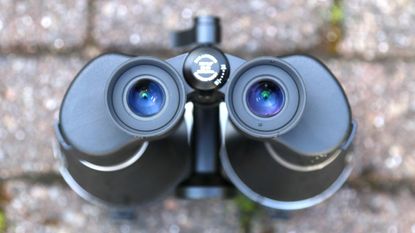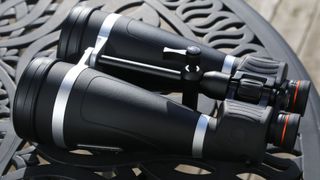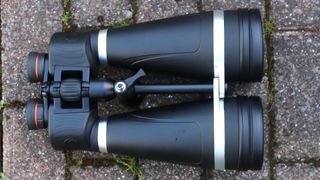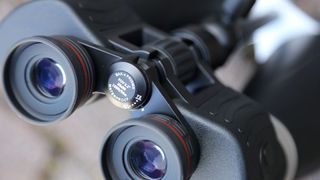Celestron Skymaster Pro 20x80 binoculars review
The Celestron Skymaster Pro 20x80 binoculars offering incredible immersive views of the deep sky, and are a travel-friendly alternative to a telescope. Here's our review


With bags of magnification and huge objective lenses, the Celestron SkyMaster Pro 20x80 are some of the largest binoculars you're ever going to find. However, if you've been considering buying a telescope then this more portable and easier to use pair of giant-sized astronomy binoculars should be in your crosshairs.
-
+
Superb design
-
+
Incredible deep-sky images
-
+
Easier to use than a telescope
-
-
Too heavy to hold
-
-
Very narrow field of view
-
-
Poor quality flared eyecups
Why you can trust T3

This Celestron SkyMaster Pro 20x80 binoculars review could change what you think about the best telescopes. You love astronomy, so it follows that you want to get your hands on one of the best telescope for beginners as quickly as possible, right? Not necessarily. A good first choice for a telescope is around 80 mm/3-inches, which is the exactly the same size as the objective lenses on the Celestron SkyMaster Pro 20x80, a giant-sized pair of binoculars purely designed for astronomy. Just like a telescope they need to be mounted, but unlike a telescope there's no proprietary mounts to use. In fact, Celestron merely provides an adapter for you to attach these huge binoculars to a travel tripod.
Sure, the Celestron SkyMaster Pro 20x80 binoculars are hardly lightweight compared to other models, but when compared to even the smallest telescopes it's a lot easier to carry, set-up and use. Oh, and you just happen to get immersive ‘steer’ views of some of the night sky’s most exciting sights. Here’s why we think you should consider the Celestron SkyMaster Pro 20x80 binoculars if you want a closer look at star clusters, galaxies and nebulae in the night sky. Or check out our binoculars vs telescope for stargazing explainer to read more about the pros and cons of each option.
Celestron SkyMaster Pro 20x80 binoculars review: price and release date
The Celestron SkyMaster Pro 20x80 cost around UK£249 / US$299 / AU$365 and originally went on sale in 2017. Also available from Celestron in the SkyMaster Pro range of porro prism binoculars is the Celestron SkyMaster Pro 15x70, which are best considered entry-level ‘giant’ astronomy binoculars. You’ll also find standard (i.e. non-Pro) SkyMaster products in 12x60, 15x70, 20x80, 25x70 and 25x100 specifications, which are slightly less bright and have a slightly larger field of view. Only the SkyMaster Pro models have Celstron’s proprietary XLT coating technology as well as a detachable rail for attaching a red dot finder scope.
Celestron SkyMaster Pro 20x80 binoculars review: design and features
Celestron SkyMaster Pro 20x80 binoculars specs
Magnification: 20x
Objective diameter: 80mm
Field of view at 1000m: 56m
Closest focusing distance: 20.2m / 66ft
Eye relief: 15.5mm / 0.61"
Weight: 2.45kg / 86.4oz
Dimensions: 330 x 241 x 102mm / 13 x 9.5 x 4"
The SkyMaster Pro 20x80 are unusual binoculars, and not just in terms of their giant size. The oddest thing about them is perhaps their centre support rail, which is integral for keeping them balanced during observing. The SkyMaster Pro 20x80 boasts a porro prism design, which is a slightly outdated way of designing modern binoculars. Despite allowing more light in than rival roof prism binoculars, porro prism products do tend to be bulky, so for the most part are ignored by binocular manufacturers trying to make more portable high-end products. That's not really of concern to Celestron for the SkyMaster Pro 20x80, which are thus maximised for light-gathering. Besides, these binoculars are so big that they do need to be mounted on a tripod.
That centre support rail is positioned between the two polycarbonate and aluminium tubes of the SkyMaster Pro 20x80, which boasts BaK-4 glass prisms and XLT-coated optics, which Celestron claims boosts light transmission and colour accuracy.

Celestron SkyMaster Pro 20x80 binoculars review: build and handling
At 86.4oz/2.45g they’re not exactly super-lightweight and they’re certainly too heavy to hold steady enough to use properly on anything other than a tripod, but the provision of a good quality shoulder bag means you can easily take the SkyMaster Pro 20x80 almost anywhere to find dark skies. As a package it's far easier to carry and set-up than a small telescope. The crucial ingredient you have to add to the package is a photographic tripod.
Attached to that centre support rail is a rod sporting a regular tripod thread, which can be attached to any ball head or pan tilt head via a baseplate. It's not complicated stuff. What is slightly more advanced is that the rail also includes a reflex sight rail for attaching a red dot finder, something that enables owners of telescopes to more accurately aim at objects in the night sky. To see that option on a pair of binoculars is rare. There isn't a red dot finder in the box, but you can buy them cheaply online. It makes the SkyMaster Pro 20x80 seem even more convincing as a different option to buying a telescope.

Celestron SkyMaster Pro 20x80 binoculars review: performance
The SkyMaster Pro 20x80's size and the fact they need to be mounted on a tripod means these aren't great for nature-spotting (if that's your priority, head to our best binoculars for birdwatching guide instead). So while you could use them for something else, these are designed primarily for astronomical observing.
It's easy to use centre focus knob means you can take the SkyMaster Pro 20x80 outside, aim it at any object and focus quickly for a great view. Try doing that with a telescope, which demands unpacking, constructing and swapping-in various eyepieces, as well as aligning with bright stars (if it's a Go-To model). However, what you will need to use the SkyMaster Pro 20x80 proficiently is a good understanding of the night sky, and the location of the objects you want to point it at.

During my review I located the Andromeda Galaxy, the Double Cluster in Perseus and the Great Globular Cluster in Hercules, with the SkyMaster Pro 20x80 giving good contrast across its 3.2° field of view, though there’s a slight drop-off in detail close to the edge. We did try using the flared eyecups that come with the SkyMaster Pro 20x80 primarily to block unwanted sources of light, but they refused to stay fixed to the eyecups. That’s poor design.
Although you can use the SkyMaster Pro 20x80 with any tripod, bigger is (much) better. The taller your tripod, the easier you’ll find aiming and observing. Go for a tripod with a maximum height of at least 180cm/71 inches, preferably with a ball-head to make aiming easier.

Celestron SkyMaster Pro 20x80 binoculars review: alternatives to consider
The Celestron SkyMaster Pro 20x80 goes up against the Orion 20x80 Astronomical Binocular, which comes with a tripod included. A smaller alternative that can just about be handheld is the step-down Celestron SkyMaster 15x70, though if you’re happy to leave them at home then the ultra-giant-sized Celestron SkyMaster 25x100 binoculars offer something extra-special in terms of size.
Celestron SkyMaster 15x70 binoculars review: verdict
Are you ready to park the idea of buying one a telescope and instead go for some of the best large aperture binoculars round? Aimed at amateur astronomers wanting a close-up of deep sky objects and the Moon, the Celestron SkyMaster Pro 20x80’s huge 80mm objective lenses, 20x magnification and support rod/built-in tripod adaptor makes it easy to use – and it offers incredible views. However, you’ll need to know the night sky reasonably well to manually locate your target (something a small ‘Go To’ telescope might do for you) and the taller your tripod, the better.
Sign up to the T3 newsletter for smarter living straight to your inbox
Get all the latest news, reviews, deals and buying guides on gorgeous tech, home and active products from the T3 experts
Jamie is a freelance journalist, copywriter and author with 20 years' experience. He's written journalism for over 50 publications and websites and, when he's not writing, spending most of his time travelling – putting the latest travel tech through its paces.
-
 Catch this thriller before a huge remake arrives – it leaves Netflix very soon
Catch this thriller before a huge remake arrives – it leaves Netflix very soonAmerican Psycho is getting updated
By Max Freeman-Mills Published
-
 Everyone should watch this western before it disappears this week
Everyone should watch this western before it disappears this week3:10 to Yuma is one of my all-time favorites
By Max Freeman-Mills Published
-
 You only have days to watch this Oscar-nominated Denzel Washington movie on Netflix
You only have days to watch this Oscar-nominated Denzel Washington movie on NetflixAmerican Gangster disappears very soon
By Max Freeman-Mills Published